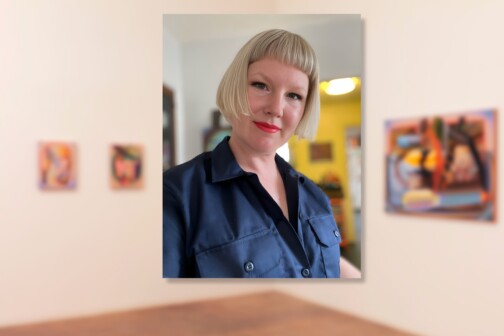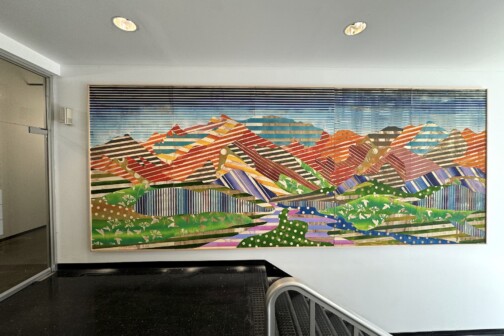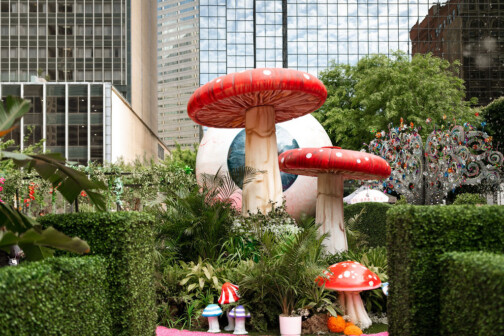Mention Italian-born artist Harry Bertoia’s name at a dinner party and watch art, architecture, and design junkies nod in recognition. It’s likely they’ll know the Diamond Chair, which has had such an outsize influence on dining furniture that copycats of its graphical metal form have trickled down to Walmart.
Or maybe they’ve encountered one of his 52 large-scale commissions, which can be found around the country in office buildings, airports, and even in the concourse of the downtown branch of the Dallas Public Library. But until now, there haven’t been opportunities to really encounter Bertoia’s prolific, wide-ranging career as a sculptor, printmaker, collaborator, designer, and visionary artist.
“Harry Bertoia: Sculpting Mid-Century Modern Life,” on display at the Nasher Sculpture Center through April 24, is the first retrospective of his work in more than 40 years, offering viewers an equally expansive and incisive look at one artist’s exploration of the impact forms or objects can have on space.
In 1930, Bertoia moved to Michigan at the age of 15 and eventually studied at the Cranbrook Academy of Art. He met Charles and Ray Eames, Florence Knoll, and Eero Saarinen, all of whom would become collaborators throughout his lifetime. Over his career, Bertoia joined the ranks of significant mid-century artists like Alexander Calder, Henry Moore, and Isamu Noguchi. But posthumously, Bertoia’s artistic contributions are often reduced to his iconic chairs, which continue to be sold by Knoll today.

The Nasher exhibit encourages viewers to reconsider the legacy of Bertoia. During his lifetime, his work was highly sought after as small and large-scale installations. He collaborated with high profile architects like Eero Saarinen and Gordon Bunshaft. But it was also disregarded by pockets of the general public, including former Dallas Mayor R.L. Thornton, who, called the Bertoia commission at the downtown library – a 3,000 pound textured screen of copper, nickel, and brass – “a bunch of junk painted up.”
In a back and forth chronicled on the front page of the Dallas Morning News, city council members and journalists questioned whether this was in fact a “mural” as had been originally promised in the 1952 design by architect George Dahl. Within three months in the summer of 1955, it was installed, then removed, then purchased by Dahl for himself. Finally, a group of private residents, led by Roberta Camp, financed the restoration of the piece to the library just in time for the grand opening. When the J. Erik Jonsson Central Library opened across from Dallas City Hall in 1982, the mural was installed in the concourse where it hangs today.
The Nasher exhibition places this screen in context with Bertoia’s oeuvre, which doesn’t follow a linear evolution. There are no clear periods and there is no chronology; rather, the artist returns to ideas and methods of making over time, organically weaving together his distinctive use of materials. Curator Marin R. Sullivan explains that Bertoia’s restless mind led him to pursue an artistic practice that resembled the way nature creates.
Fair or not, Bertoia’s place in the artistic consciousness has sometimes been reduced to that of a furniture designer. Curators Jed Morse and Sullivan argue that the reason for this is that the artist’s modernist maximalism abutted the rise of minimalists like Donald Judd and Robert Morris. Bertoia made each of his works by hand, eschewing outsourcing his work to a fabrication studio.
This makes the range, scope, and scale of the more than 100 pieces on display at the Nasher all the more impressive. There is an extravagant craftsmanship present in his pieces, like the sturdy brass, copper, and steel “Tree” in the museum vestibule, the more delicate “Cloud” constructions, the intricate screens made of thousands of welded nails. But there is also a spontaneity resembling the process of the abstract expressionists in some of his works, like the spill cast series.
All art requires an encounter, but Bertoia calls a viewer’s attention to how that encounter shapes the room or space around it –the weight, the scale, the texture, the color, or, in the case of one of his more famous bodies of work, the sound. As part of the exhibition, gallery attendants will regularly demonstrate the collection of Bertoia’s sound sculptures, which include large round gongs and tall, spindly reeds that when pushed sway into one another to create tones that reverberate throughout the space. Bertoia coined the term “sonambient” to describe these environments created through sound.
In conjunction with the exhibit, the Nasher commissioned Chicago-based sound installation artist Olivia Block to create a sonambient piece using Bertoia’s sculptures. Tucked into the corner gallery, Block’s work responds to the patterns of visitors walking through the space, while shadows of the reed-like works flitter on the ground.
Programming related to the exhibition will take place at the Dallas Public Library. The Nasher will host an entire week of concerts, “Sculpting Sound: Twelve Musicians Encounter Bertoia,” at the end of February. As visitors encounter this stunning exhibit, it will likely reshape the encounters they have with Bertoia’s work—whether it be in a library, office building, airport, or at the dining room table.






